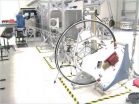Gene discovery could lead to better soybean varieties for Northern United States
2014-07-15
(Press-News.org) WEST LAFAYETTE, Ind. – Researchers from Purdue University and the University of Nebraska-Lincoln have discovered a soybean gene whose mutation affects plant stem growth, a finding that could lead to the development of improved soybean cultivars for the northern United States.
Purdue agronomy professor Jianxin Ma (pronounced Jen-SHIN' Ma) and collaborators identified a gene known as Dt2, which causes semideterminacy in soybean plants. Semideterminate soybean plants - mid-size plants that continue vegetative growth even after flowering - can produce as many or more pods than current northern cultivars but do not grow as tall. Their reduced height makes them more resistant to lodging, a bending or breaking of the main plant stem.
"This gene could help us improve the yield potential and adaptability of soybeans for specific growing areas," Ma said. "We can now focus on developing a variety of elite semideterminate soybean cultivars, which could perform very well in high-yielding, irrigated environments such as Nebraska and northeastern Indiana."
Soybean cultivars are often divided into two groups: indeterminate - tall plants whose main stem continues to grow after flowering - and determinate - shorter, bushier plants whose main stem halts growth when blossoms begin to form.
Determinate soybean plants thrive in the longer growing season of the south while indeterminate plants' overlapping vegetative and reproductive stages make them better suited to the north. But the height of indeterminate cultivars renders them prone to lodging.
For northern soybean producers, semideterminate soybean plants could represent a "Goldilocks" cultivar, a "just right" alternative between the two. Semideterminate soybeans are easy to manage, have similar or better yields than indeterminate plants and can handle a short growing season, Ma said.
Only one semideterminate soybean cultivar, NE3001, is common in the United States. Having pinpointed Dt2 will enable Ma and his researchers to use natural plant breeding methods to develop a variety of semi-determinate cultivars.
"The potential for soybean yield productivity in the U.S. has not been fully explored, in part because of the lack of semideterminate cultivars," he said. "We're now working on converting high-yielding indeterminate cultivars to semideterminate types to test their yield potential."
Ma - who had previously identified Dt1, the gene that causes indeterminancy in soybeans - used an integrated genetic approach to isolate and characterize Dt2. After identifying the gene, he inserted it into indeterminate cultivars to confirm that it caused the plants to become semideterminate. Dt2 suppresses the expression level of Dt1, causing soybean plants to grow shorter.
Ma said this type of mutation appears to be unique to soybeans as semideterminancy in other plants such as tomatoes and chickpeas is caused by a different genetic mechanism.
Study co-author James Specht, a professor of agronomy and horticulture at the University of Nebraska-Lincoln, said the identification of Dt2 gives soybean breeders a powerful tool for breeding new cultivars.
"This provides breeders with a perfect genetic marker for identifying semideterminancy in soybean seeds and seedlings," he said.
INFORMATION:
The paper was published in The Plant Cell and is available at http://www.plantcell.org/content/early/2014/07/08/tpc.114.126938.full.pdf+html
Other collaborators on the study are Thomas Clemente at the University of Nebraska-Lincoln, Randall Nelson at the U.S. Department of Agriculture and the University of Illinois and Lijuan Qiu at the Chinese Academy of Agricultural Sciences.
Funding for the research was provided mainly by the United Soybean Board and partially by the Partnership for Research and Education in Plant Breeding and Genetics program of the U.S. Department of Agriculture's National Institute of Food and Agriculture, Ag Alumni Seed, AgReliant Genetics, Beck's Hybrids, ConAgraFoods, Dow AgroSciences, Indiana Crop Improvement Association and Pioneer Hi-Bred International.
Written by Natalie van Hoose
ELSE PRESS RELEASES FROM THIS DATE:
Transparency lacking in clinical trials, BU study finds
2014-07-15
A significant percentage of completed drug clinical trials, especially those funded by industry, are not disclosed to the public, years after being completed—a trend that "threatens the validity of the clinical research literature in the U.S.," according to a study led by a Boston University School of Public Health (BUSPH) researcher.
The study, published in the journal PLOS ONE, found that close to 30 percent of 400 randomly selected clinical trials completed in 2008 had not resulted, four years later, in either publication in a journal or the posting of results to the ...
Do women talk more than men? It's all about context
2014-07-15
We've all heard the stereotype: Women like to talk. We bounce ideas off each other about everything from career moves to dinner plans. We hash out big decisions through our conversations with one another and work through our emotions with discussion.
At least, that's what "they" say. But is any of it actually true? A new study from Northeastern University professor David Lazer's lab says it isn't that simple.
Lazer, who researches social networks and holds joint appointments in the Department of Political Science and the College of Computer and Information Sciences, ...
NASA's Van Allen Probes show how to accelerate electrons
2014-07-15
One of the great, unanswered questions for space weather scientists is just what creates two gigantic donuts of radiation surrounding Earth, called the Van Allen radiation belts. Recent data from the Van Allen Probes -- two nearly identical spacecraft that launched in 2012 -- address this question.
The inner Van Allen radiation belt is fairly stable, but the outer one changes shape, size and composition in ways that scientists don't yet perfectly understand. Some of the particles within this belt zoom along at close to light speed, but just what accelerates these particles ...
NOAA's GOES-R satellite Magnetometer ready for spacecraft integration
2014-07-15
The Magnetometer instrument that will fly on NOAA's GOES-R satellite when it is launched in early 2016 has completed the development and testing phase and is ready to be integrated with the spacecraft.
The Magnetometer will monitor magnetic field variations around the Earth and enable forecasters at NOAA's Space Weather Prediction Center to better predict the consequences of geomagnetic storms. These storms pose a threat to orbiting spacecraft and human spaceflight. In addition, the measurements taken by the Magnetometer will aid in providing alerts and warnings to power ...
For bees and flowers, tongue size matters
2014-07-15
For bees and the flowers they pollinate, a compatible tongue length is essential to a successful relationship. Some bees and plants are very closely matched, with bee tongue sized to the flower depth. Other bee species are generalists, flitting among flower species to drink nectar and collect pollen from a diverse variety of plants. Data on tongue lengths can help ecologists understand and predict the behavior, resilience and invasiveness of bee populations.
But bee tongues are hard to measure. The scarcity of reliable lingual datasets has held back research, so Ignasi ...
Study finds why some firms are 'named and shamed' by activists
2014-07-15
COLUMBUS, Ohio – A new study of the anti-sweatshop campaigns of the 1990s reveals which companies are most likely to become targets of anti-corporate activists.
Researchers found that companies tended to attract the attention of labor activists if they were large, had prominent brand images, or had good corporate reputations. When combined, these factors were especially important.
"Companies that had all of these characteristics were nearly guaranteed to be a target of activism," said Tim Bartley, lead author of the study and associate professor of sociology at The ...
Fundamental chemistry findings could help extend Moore's Law
2014-07-15
Over the years, computer chips have gotten smaller thanks to advances in materials science and manufacturing technologies. This march of progress, the doubling of transistors on a microprocessor roughly every two years, is called Moore's Law. But there's one component of the chip-making process in need of an overhaul if Moore's law is to continue: the chemical mixture called photoresist. Similar to film used in photography, photoresist, also just called resist, is used to lay down the patterns of ever-shrinking lines and features on a chip.
Now, in a bid to continue decreasing ...
Study: Body Dysmorphic Disorder patients have higher risk of personal and appearance-based rejection sensitivity
2014-07-15
PROVIDENCE, R.I. – In a recent study, researchers at Rhode Island Hospital found that fear of being rejected because of one's appearance, as well as rejection sensitivity to general interpersonal situations, were significantly elevated in individuals with Body Dysmorphic Disorder (BDD). These fears, referred to as personal rejection sensitivity and appearance-based rejection sensitivity, can lead to diminished quality of life and poorer mental and overall health. BDD is a common, often severe, and under-recognized body image disorder that affects an estimated 1.7 to 2.4 ...
Prostate cancer in young men -- More frequent and more aggressive?
2014-07-15
ANN ARBOR, Mich. -- The number of younger men diagnosed with prostate cancer has increased nearly 6-fold in the last 20 years, and the disease is more likely to be aggressive in these younger men, according to a new analysis from researchers at the University of Michigan Comprehensive Cancer Center.
Typically, prostate cancer occurs more frequently as men age into their 70s or 80s. Many prostate cancers are slow-growing and many older men diagnosed with early stage prostate cancer will end up dying from causes other than prostate cancer.
But, the researchers found, ...
Rollout strategy for diagnostic test in India may impact TB
2014-07-15
Xpert MTB/RIF, a recently implemented tuberculosis (TB) test, has the potential to control the TB epidemic in India, but only if the current, narrow, implementation strategy is replaced by a more ambitious one that is better funded, also includes the private sector, and better referral networks are developed between public and private sectors, according to new research published in this week's PLOS Medicine. The study by David Dowdy, from Johns Hopkins University, United States, and colleagues is a mathematical model that suggests alternative strategies that include engagement ...





